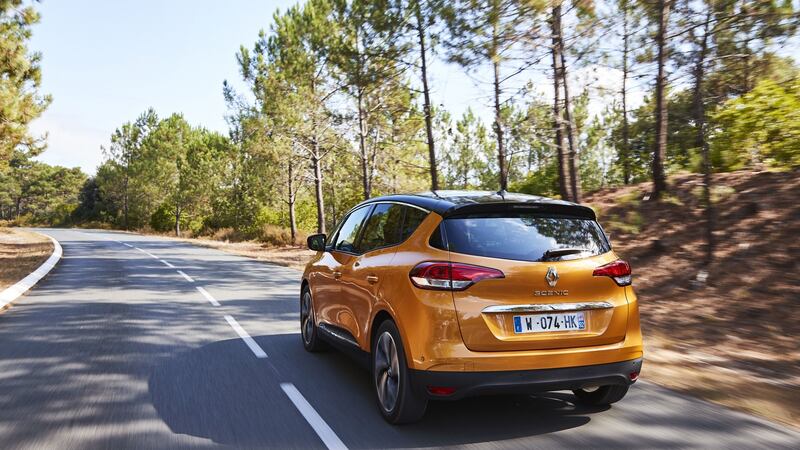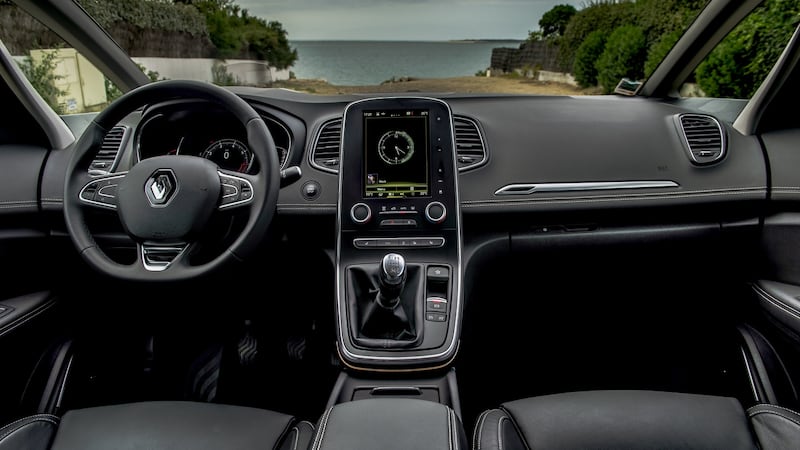So the question which arises is not will anyone buy a new Renault Scenic (which seems a little unfair – the car is hardly without appeal), but whom?
Just 24 hours before we got our first chance to drive a fourth-generation Scenic, Renault’s great rival Peugeot decided to abandon the mid-size MPV concept and instead re-invent its popular 5008 as a full-size SUV.
Skoda, likewise, has decided not to go ahead with a planned VW Caddy-based replacement for the Roomster MPV and instead has grabbed many a headline by making its own big SUV, the seven-seat Kodiaq.


Rationality
The Scenic is actually celebrating its 20th birthday this year, originally born in 1996 as the Megane Scenic, before eventually dropping the Megane suffix and becoming a model in its own right.
As ever, this fourth-generation model is a spectacularly rational car (roomy in spite of a compact exterior, frugal, well equipped) but the problem is that, increasingly, those buying a family car are abandoning rationality and buying with their gut, prepared to sacrifice (some) space and affordability to get themselves an SUV.
They are as likely now to cross the floor of a Renault showroom and buy a Kadjar or the upcoming seven-seat Koleos instead of a Scenic.
So, what to do? In a world which is increasingly shunning the MPV, a car long seen as route to surrendering one’s youth and sense of fun, how do you make a new Scenic desirable?
Renault's head of design, Laurens van den Acker was succinct on the matter. "We looked at the old Scenic III and thought – it looks like a car where the parents have fallen out of love with each other. We wanted to create a car where those sitting in the front are still very much in love," he told The Irish Times.
“The new Scenic gave us an intensive challenge – to innovate or die. Just to make it a little bit better would not have been enough to survive. We had to add sex appeal, or we might as well just give up and do a crossover.”
Sex appeal
I think in MPV terms that sex appeal has most definitely been added. Van den Acker’s work has been successful in making the Scenic looks far more desirable than the old, upright, rather blousy model.
It has lifted a lot of cues and styling from the glowering new Espace (still not coming in right-hand drive, sadly) and much of the visual height has been taken from the car, making it appear far sleeker.
As far as boxes with a wheel at each corner go (essentially what an MPV is) it’s currently the best looking. And those wheels may cause an eyebrow or two to be raised – all Scenics and Grand Scenics come with 20” wheels as standard, with no other size option.
It’s nice inside too. Renault says that 80 per cent of the car’s overall volume has been given over to the interior, something that becomes obvious when you open the bonnet and see just how tight up against the radiator the engine has been packaged.
The dashboard, with its big ski-jump of a centre console, is rather stylish although the main instruments, all digital, look rather cheap. Basic cars will get a rather measly 5” touch screen but posher versions will have a 7” or optional 8” screen.
Space is okay, but sadly not better than that. If someone in the front has long legs, or simply wants to lounge, then kneeroom in the rear is rapidly reduced. That issue is slightly less pronounced in the longer, seven-seat Grand Scenic, but it never goes away entirely. At least the boot is big – rising from 572-litres in the Scenic to a possible maximum of 765-litres in the Grand Scenic.
And quality? Well, it’s not bad – not as solid in feel as a VW or a Kia but generally quite good. However, that comes with the caveat of just how many cabin squeaks and rattles will be generated by those big 20” alloys rolling over Irish road surfaces…
Ride quality
Do they cripple the ride quality? It’s a little hard to say. The roads around Bordeaux, swopping in long, Roman straights between vineyards, were hardly the sternest test for the Scenic’s suspension (which Renault engineers aver is better than ever because it has been tuned for one wheel size, with no others about which to worry) but we definitely felt some pitching, chopping and fidgeting. It wasn’t excessive, but then the roads were generally glass-like, so it’s impossible for us to tell, yet, what it’ll be like in Irish conditions.
There seems to be no benefit to handling from the larger wheels. The Scenic’s steering is totally disconnected and over-light and the handling tends to the roly-poly end of the scale.
It is not in the least bit exciting to drive, but on longer, straighter journeys it should prove a tolerable companion, in spite of some fairly cacophonous wind noise from around the mirrors.
At least the seats are comfortable (long since a Renault speciality) and practicality is good. Three child seats will easily fit across the back bench of either Scenic or Grand Scenic, although it’s worth noting that that back bench now really is a bench – no more individual seating in the back. The third-row seats in the Grand Scenic are useful but small, for kids only really.
Engines
Engine wise, the 1.6 dCi diesel is rather noisy and growly and makes for an unhappy companion with the seven-speed dual clutch EDC gearbox. The 130hp 1.2-litre turbo petrol was rather better, if still a tad noisy. Best of the bunch was the 1.5 dCi 110hp diesel with a mild-hybrid assistance.
It won’t run on electric power only, but a 48-volt battery and an electric motor boost the engine’s torque by about 20Nm at key moments, so it feels livelier, seems quieter than the 1.6 and achieved better than 53mpg in mostly urban driving. Its emissions dip as low as 92g/km too, but there’s likely to be a significant price premium.
But who will buy one? Much depends on the price, upon which Renault Ireland has not yet decided and it seems likely that, as with most new vehicles from a mainstream manufacturer, there will be an attempt made to "move upmarket".
Certainly, there won’t be a cheap-y entry-level €23k Scenic as there is now, but one has to consider that standard safety equipment has seriously increased, and will include autonomous emergency braking with pedestrian detection.
Even so, who will be interested? Will the sexier styling and the child-friendly cabin be enough to steer buyers away from their SUVs? Or should van den Acker have just given up and done another crossover?
The lowdown: Renault Grand Scenic 1.6 dCi.
Price: TBA.
Power: 130hp.
Torque: 320Nm.
0-100kmh: 11.4sec.
Top speed: 190km/h.
Claimed economy: 4.5-litres per 100km (62mpg).
CO2 emissions: 116g/km.
Motor tax: €200 per annum.
Verdict: The most stylish MPV around? Probably, but has the SUV boom already left it behind?
Our rating: 3/5












